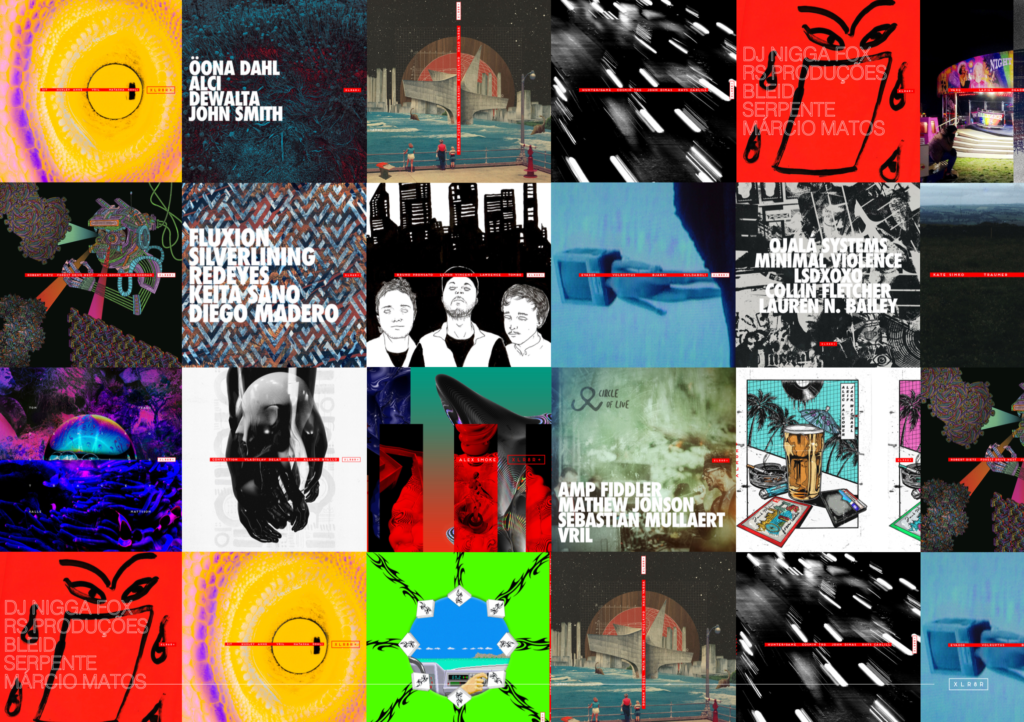In the Studio: Wata Igarashi
The processes behind the Japanese artist's deep, sci-fi tinged techno.
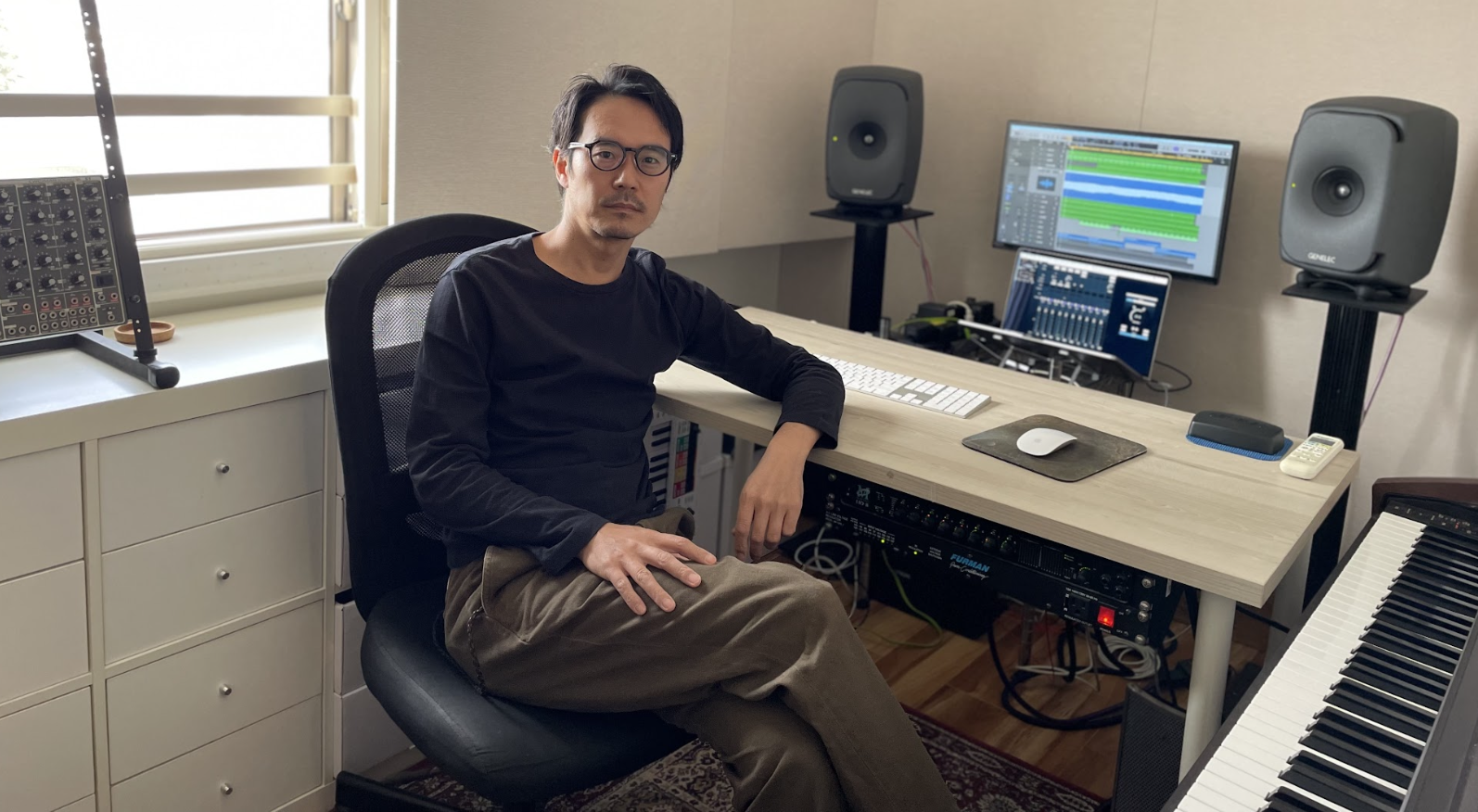
In the Studio: Wata Igarashi
The processes behind the Japanese artist's deep, sci-fi tinged techno.
Wata Igarashi is one of the leading figures of Japanese techno—an XLR8R favorite who featured in our XLR8R+ series and delivered a podcast of deep, sci-fi tinged hypnotic techno in 2019. What we haven’t covered so much before are his productions, which have been released on labels including Figure, Semantica, Time to Express, The Bunker NY, and Midgar, conveying a sound that’s powerful, precise, and psychedelic; functional but refined.
In April, on Kompakt, he released Agartha, his much-anticipated debut album that’s typically beautifully detailed but broadens Igarashi’s sonic realms into the smoky, improvised jazz, the minimalism of Steve Reich, and even Krautrock and ‘90s electronica. He produced all 10 tracks over 18 months in his studio in Tokyo, Japan, where he fuses his electronic output with compositions for moving pictures. Earlier this year we paid him a visit to learn more about the processes behind them.
Tell me about your studio. When did you move in here?
In late 2016, I relocated to this apartment in Setagaya, Tokyo. Upon settling in, I sought the assistance of Acoustic Engineering Inc. to convert one of the rooms in the apartment into a music studio. Despite the limited space available, I am extremely pleased with the sound quality that has been achieved.
What do you look for in a studio space?
A quiet comfortable place with quality sound.
When you were speaking to Acoustic Engineering Inc., what were your key desires for the space?
The sound quality was definitely my first priority. I didn’t want to cause any trouble for my neighbors either. Fortunately, only the floor of my studio room was connected to my neighbor’s apartment. So, I asked them if we can prevent the sound from reaching their living space. They did an excellent job of making sure both the sound quality and insulation were perfect.
Do you think it is important that you have a studio that’s clearly defined from your home space?
Yes. Having a designated workspace is important for me, especially when it comes to music productions. Ideally, I would prefer a studio outside of my home to avoid blurring the lines between work and off-time. Working from home can be convenient, but it’s easy to get caught up in it and lose track of time. I prefer having set working hours and being able to mentally switch off after a certain time. Commuting to a separate workspace also has a certain ritualistic feel that can help get me in the right mindset for creating. But it wasn’t economically feasible to have a studio outside of my house in Tokyo. However, I did invest in a super heavy soundproof door, one of those metal ones with a big door handle bar that you see at proper studios. When I close that door, I know it’s time to get into music mode!
Do you ever suffer with a production block, and how do you combat it?
Yeah, I totally get it. Sometimes no matter how hard you try, the production block just hits you hard. I wish there was a shortcut to get around it but there isn’t. Personally, I spend about 30 minutes on a track and see if it’s going anywhere or not. If it’s not working out, I just move on to another project. There’s no point in wasting more time on something that won’t improve. As a result, I have a bunch of unfinished projects on my hard drive. Even when I revisit them after years, they still don’t work, unfortunately. However, if I’m happy with the loop after 30 minutes, then I can usually get the basic structure of the track done within the next few hours. These are usually the ones that end up getting released.
It’s funny that you simply cut a track that doesn’t flow after 30 minutes, because I think some artists try to work through this. Have you ever battled through that wall? Do you ever think battling through that wall is worth it?
I believe whether it is worthwhile to engage in a battle depends on the situation. If I hear one potential element, then it is definitely worth continuing, even if it demands some time and effort. Through experimentation, some unexpected ideas could end up coming out from it. However, it is also crucial to recognize when it is appropriate to let go, at least from my perspective. Considering there is only limited time to create music for me, I aim for efficiency in managing my time while going for a higher rate of producing music that resonates with me. I suppose this lesson became apparent to me while producing music for advertisements, where I encountered situations where I only had a few hours to deliver a track.
So, are there loads of unfinished sketches for Agartha?
There are a few, yes. I even had some completed tracks for Agartha, but I ended up keeping the ones that flowed nicely together as part of a conceptual album. As for the tracks that didn’t make it onto the album, I am considering releasing them on my WIP label in the future.
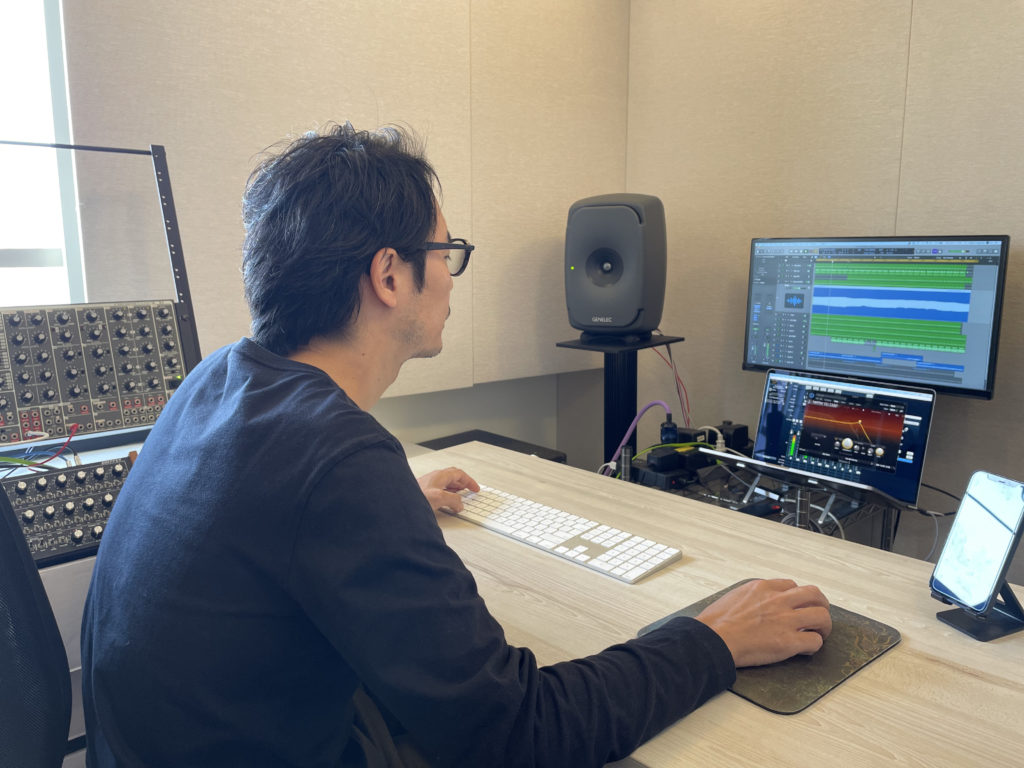
What are the key pieces of equipment at the center of your work? In particular Agartha?
As a long time Logic Pro user, I exclusively utilized the software for the entire process of composing, recording, and mixing the album. For recording certain acoustic sounds, I used an AKG C414 microphone in conjunction with the superlative pre-amp of Metric Halo’s Lio-8 audio interface. In addition to analog synths like Cwejman S1, Moog Mother-32, and a few modular synths, I also incorporated some of my favorite plug-in synths, including Twin 2, Prophet V5, Minimoog V, Buchla Easel V, ES1, ES2, ESM, and various others to complete the album.
Have you always worked this way? How did your setup look for your earlier material?
I’ve been producing music this way since I started making techno. I think it’s because I started with the guitar, and most instrument players stick to one instrument to perfect it throughout their lives. I have a similar mindset when it comes to producing; I don’t like to switch around too much gear, and I just often prefer to spend my time making music instead of learning a new instrument. In the end, what matters most to me is the final music itself, not necessarily the tools used to create it.
When did you first begin producing your own music?
I began producing my own music about 16 years ago, when I was working at Syn, a music production company in Tokyo, as an in-house composer. At Syn, I made hundreds of tracks for advertisements, always following the directions given by the director and the clients. While it is fun and interesting to produce all this different kind of music professionally, I started feeling the need to take complete control over my music and create it the way I wanted, instead of following someone else’s directions. That’s when I started producing my own music, to be able to craft it exactly the way I wanted, without any external influences!
What do you look for in the equipment that you use?
When it comes to the equipment I use, I am always looking for something that resonates with me on a deeper level. I like it when a piece of gear becomes more than just a tool to make music and it feels like I have a deeper relationship with it. Take my Roland TB-303, for example. Sure, I love the sound it produces, but I also like the way it looks and feels. Even though the buttons don’t work perfectly and programming the sequence can be a pain, it’s all part of the instrument’s charm and I just can’t help but love it. I know it might sound crazy, but there’s almost a romantic feeling that comes with using it. The same goes for my Cwejman Sound S1. Does that make me crazy? Maybe, haha.
Can you talk about your working relationship with the Cwejman Sound S1 and the Doepfer Dark Time, and how they fit into your process?
One of my favorite techniques for creating arpeggios is using the Cwejman S1 and its three oscillators positioned to three different octaves. This approach produces a rich low-end and crystal-clear highs, and by manually manipulating the octaves it can add an organic feel to an otherwise rigid and somewhat cold arpeggio line. While I often compose my arpeggios based on the melodies that I hear in my head, I also enjoy the unpredictability of using the Dark Time to generate unexpected and intriguing sequences. Sometimes it results in weird lines that I would not have been able to create through other conventional ways.
Can you give an example of where we can hear this in your work?
The Cwejman S1 is used on many of my productions, but one of them is Aurora Halal’s Eternal Blue Crossing Remix, where I used the S1 to create arpeggios that are prominent throughout the song. The track “Lost” from my Sekawa EP features the S1 and the Doepfer Dark Time. The Dark Time generated these weird unexpected sequences which went into the S1.
Are these melodies you hear in your head coming to you at all times, even outside the studio? And how do you go about transferring them into recorded works?
The melodies I come up with often pop up in my head when I’m not actively composing, like when I’m walking or sleeping. I don’t always remember to take note of them, so sometimes I forget them entirely. But some of the catchy ones just stick in my head or come back again later on at a completely different occasion. I try to transfer those remembered ideas into recorded works. That, though, is not the only way I compose. I do also sit down and intentionally compose melody lines and sequences. A lot of the music on Agartha was created through the traditional method of sitting in front of a piano or a guitar and playing around with ideas. My music a mix of spontaneous inspiration and intentional composition.
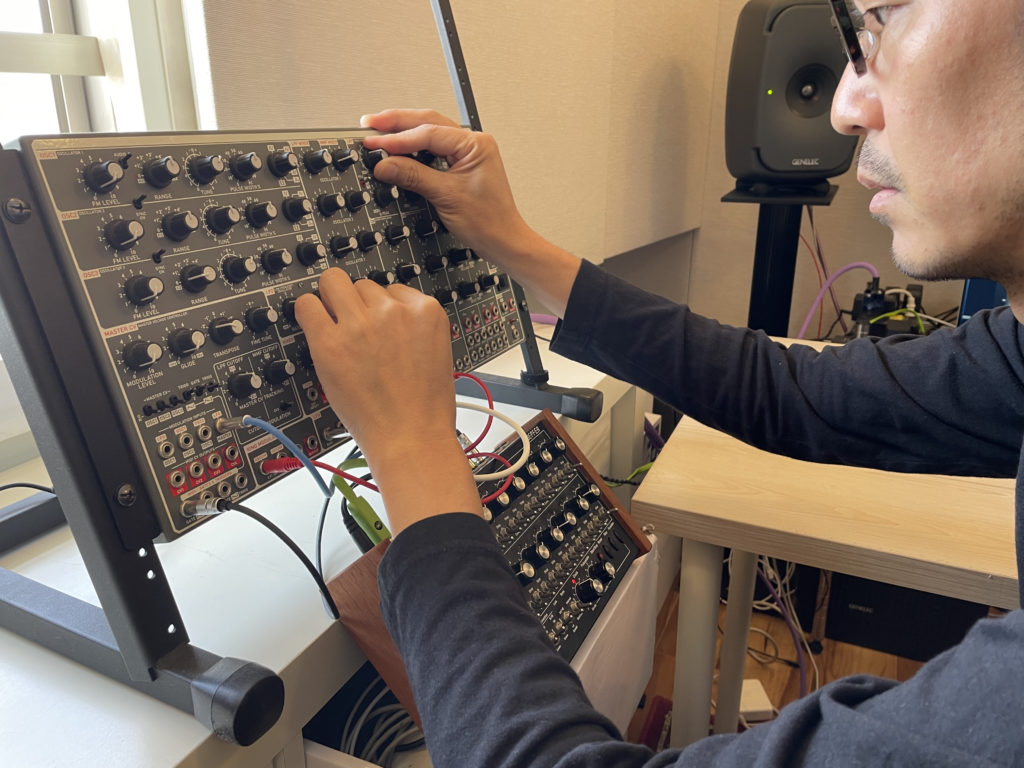
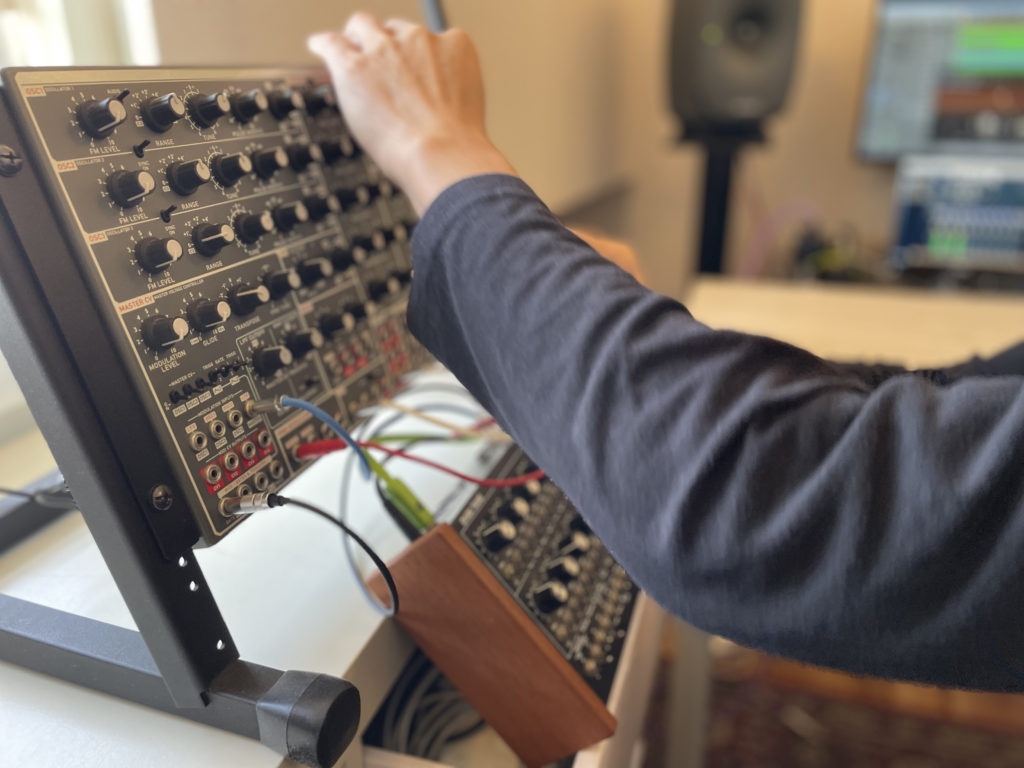
You have a range of out-board analog gear, from grooveboxes to FX units. How often are you working with these machines? Do you have a patch bay or routing set up to allow for easy switching between gear?
Due to the limited space in my studio, I typically keep most of my gear disconnected and stored on shelves. When working on a track, I usually have a clear vision of the specific sound I want to achieve. I then proceed to take out the necessary gear or plug-ins that are associated with that sound and experiment with it until I achieve the desired outcome.
It’s interesting that so many of your melodies and tracks are so preconceived. What’s an example of a specific sound and how did you achieve it?
When I created the bass sound for “Roar” from WIP07 EP, it was with a specific purpose in mind. I wanted a kind of deep bass sound that would be so powerful to blow minds to play at Balance festival* in the mountains of Gunma. I was imagining the floor in the deep nature and that bass sound just resonated in my head. Then I went into the studio to recreate it. Initially, I experimented with Moog Minimoog V with different distortions and reverb settings, but eventually, I blended a few other synths to achieve the sound. When I dropped the demo version for the first time at Balance, Kuniyuki [Takahashi] came straight to the booth, asking “What the heck is this!?” and I remember feeling a sense of accomplishment in that moment!
It’s not always easy to realise a sound you have in your head. What’s the secret?
I usually start by trying to create mockups of sounds in plug-in synths before going to analog gear. It’s faster and easier this way, and helps me to get a clear idea of how I want the sound to be. Sometimes, I end up using the first sketch on the plug-in synth, but often I replace the sound with the actual gear.
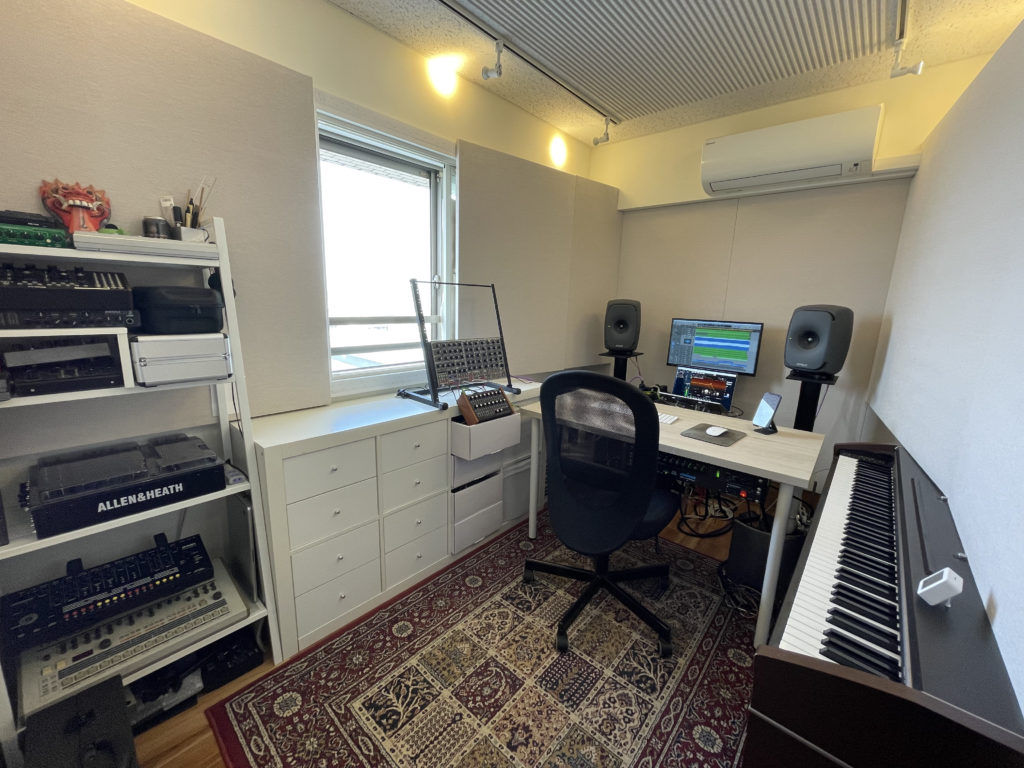
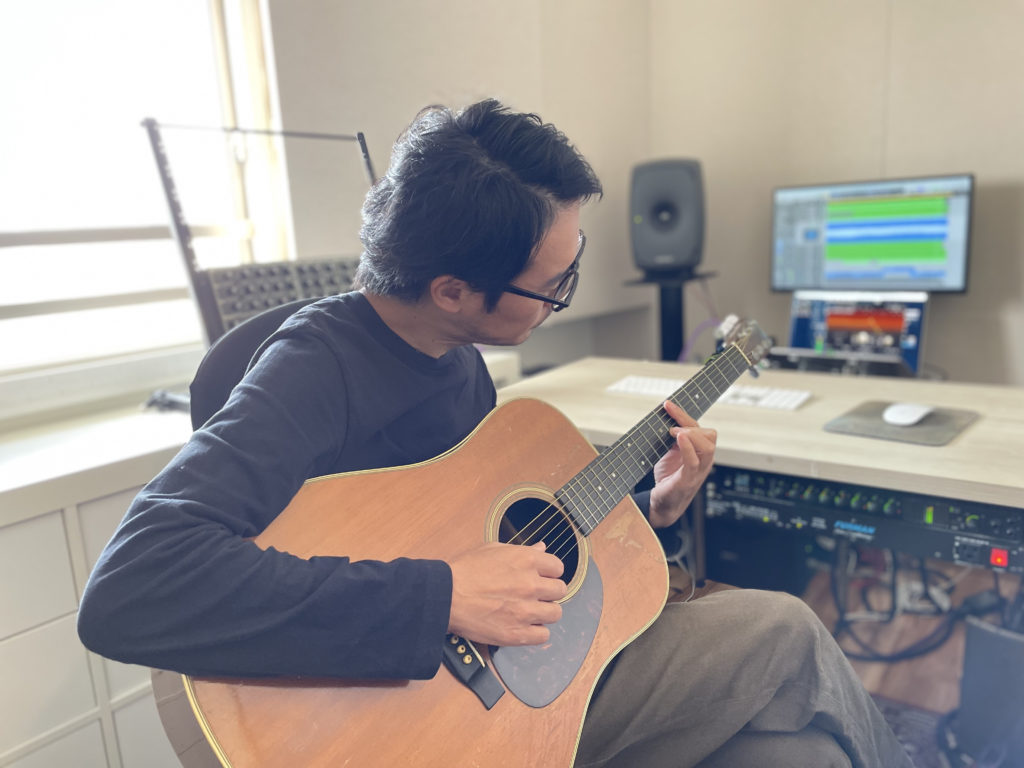
The acoustic guitar seems like the odd piece in your studio, and in regards to your music. How does it fit in here?
I have been playing the guitar since I was in middle school, which is considerably longer than the time I have been using synthesizers. So, I have a strong affinity for the sound of acoustic guitars and frequently incorporate it into the compositions I create for advertisements or events. The guitar has played a crucial role in shaping my musical taste. Without it, the sound of my techno and ambient music would not have the same essence that it currently possesses.
So, how does your production process actually begin?
Typically, my music production process begins with me opening my notebook and writing down the essence of the sound I hear or want to create in the track. Before I start making any sound, I like to have a clear idea of what I want to convey in the track. If it is a techno track, it could be something that I wish I had while DJing. Could be a feeling I get while traveling the world or something odd from my dreams. I could also just imagine the weirdest things like, “What if I had only different kick drums and nothing else?” This approach to making music can be challenging but also enjoyable. I take note of all these things and write them down first.
Remember, I am accustomed to writing songs for advertisements, where all the concepts are outlined before composing the music. Therefore, it is natural for me to recreate the sound from the concept. Sometimes, I am unable to achieve the exact sound I was aiming for, but it often ends up being better than my original idea, and that is okay too.
After I am happy with the sound I recreated from what I envisioned, I start adding new elements that were not in the original essence to enhance the music. Following the concept alone could be interesting, but it does not always work as a final track by itself. This second part adds depth or catchiness to the original idea. After that, it becomes a matter of polishing the track.
Is there always such a formula for a track?
Well, there are instances, particularly when I acquire a new piece of equipment and am in the process of familiarizing myself with its features and capabilities, where I accidentally get some truly captivating sounds that have the potential to become a central element of a track. In these situations, I allow myself to explore these new sonic possibilities to incorporate them into my music. It can be a highly rewarding and exciting experience to discover unexpected sounds and integrate them into my creative process. These new ideas and techniques could potentially lead my music to evolve and grow over time.
Can you walk us through the production of one of your favorite tracks?
Sure. How about “Tunneling” from WIP08, which was released last November?
I had the concept first. It was before going on a tour to Colombia and I wanted a new track that would work well for this tour. I thought a simple bassline-oriented techno track that drives and grooves hard would work well there, or anywhere actually. Nothing sophisticated, just a simple track with energy that keeps the dancers moving. I also wanted some kind of syncopation, so it’s not super straight. I knew the bassline had to be solid and hard, and I had the ESM from Logic in my mind for it from the beginning. For those who don’t use Logic, it’s basically similar to a 303 style mono synth, but they made it in a way that even with resonance and cutoff set to high, the low-end still remains, unlike the original 303 where you do the same and the low end disappears, and the frequency of the cutoff is a lot more dominant. You can make a really fat bass line with ESM plus a bit of extra distortion. This bass and the syncopated kick pattern were the main part of the track and were completed in like 20 minutes. I felt the bass with made with just the ESM missed some kind of gritty character so I overdubbed the same phrase with the Buchla Easel V. The main part being done, I added some simple 909 hi hats and a high-frequency rhythmic pattern made with white noise to lay the rhythm parts. I worked on it a bit further tweaking the kick and other minor details but it was done fairly quickly.
How do you know when your songs are done? Do you show them to anyone else before you release them?
Many of my tracks were produced in a single day. In my experience, the problem of not knowing when to consider a track complete often happens, especially for techno tracks, when you have worked on it for an extended period, like several days or even longer. Once I feel the track is done, I will bounce it and let it sit for a couple of days. With fresh ears, I will listen to the track and if I notice any areas where parts are missing or seem unnecessary, I will return to the studio to fix them. I repeat this process until I am fully satisfied with the track. For techno tracks, I like to test them out at shows to ensure that they deliver the intended effect. I don’t usually share my demo tracks until they have been mastered, to make sure that the track sounds its best when played by other DJs.
What is your approach in regards to mixing?
I feel lucky to have had the opportunity to work with various talented mixing engineers in Tokyo on advertisement projects. By observing their techniques and approaches, I have learned a range of basic to advanced mixing techniques which helps to create well-crafted, clean, and polished mixes. While functional mixing is essential for many musical genres, I believe that for music like techno, mixing is also an important component of artistic expression. I view mixing as an opportunity to augment the personality and character of the music, while ensuring it is functional on the dancefloor. To achieve this, I prioritize the core message or main sound of the music and am not hesitant to eliminate parts that may detract from the core focus of the track.
How often are you testing tracks out when DJing? Are you actively making notes when/if doing so?
I test out almost every time. I make techno tracks for my DJ sets. If it sounds quite different on the dancefloor or in the booth from my intended mix from the studio, I get disappointed so I can easily remember them. So I don’t even take notes!
**Balance was organized by the team behind Labyrinth.
Photos: Ayako Haruta

